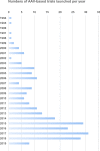Evolving AAV-delivered therapeutics towards ultimate cures
- PMID: 33594520
- PMCID: PMC7885987
- DOI: 10.1007/s00109-020-02034-2
Evolving AAV-delivered therapeutics towards ultimate cures
Abstract
Gene therapy has entered a new era after decades-long efforts, where the recombinant adeno-associated virus (AAV) has stood out as the most potent vector for in vivo gene transfer and demonstrated excellent efficacy and safety profiles in numerous preclinical and clinical studies. Since the first AAV-derived therapeutics Glybera was approved by the European Medicines Agency (EMA) in 2012, there is an increasing number of AAV-based gene augmentation therapies that have been developed and tested for treating incurable genetic diseases. In the subsequent years, the United States Food and Drug Administration (FDA) approved two additional AAV gene therapy products, Luxturna and Zolgensma, to be launched into the market. Recent breakthroughs in genome editing tools and the combined use with AAV vectors have introduced new therapeutic modalities using somatic gene editing strategies. The promising outcomes from preclinical studies have prompted the continuous evolution of AAV-delivered therapeutics and broadened the scope of treatment options for untreatable diseases. Here, we describe the clinical updates of AAV gene therapies and the latest development using AAV to deliver the CRISPR components as gene editing therapeutics. We also discuss the major challenges and safety concerns associated with AAV delivery and CRISPR therapeutics, and highlight the recent achievement and toxicity issues reported from clinical applications.
Keywords: Adeno-associated virus; Gene editing; Gene therapy; Gene transfer.
Conflict of interest statement
The authors declare that they have no competing interests.
Figures
References
-
- Atchison RW, Casto BC, Hammon WM. Adenovirus-Associated Defective Virus Particles. Science. 1965;149:754–756. - PubMed
-
- Balakrishnan B, Jayandharan GR. Basic biology of adeno-associated virus (AAV) vectors used in gene therapy. Curr Gene Ther. 2014;14:86–100. - PubMed
-
- Samulski RJ, Muzyczka N. AAV-Mediated Gene Therapy for Research and Therapeutic Purposes. Annu Rev Virol. 2014;1:427–451. - PubMed
Publication types
MeSH terms
Substances
LinkOut - more resources
Full Text Sources
Other Literature Sources
Medical
Research Materials


